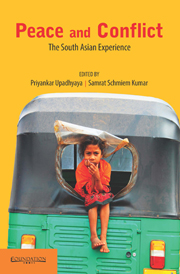Book contents
- Frontmatter
- Contents
- Foreword
- Preface
- Introduction
- 1 Conflict Resolution and Peacebuilding: Ideas, Approaches and Debates
- 2 Changing Perspectives on Peace Studies in South Asia
- 3 Peace Pedagogies in South Asia: Interreligious Understanding
- 4 Responses of Communities to Social Tension
- 5 Plurality of Peace, Non-violence and Peace Works in India
- 6 Education and Culture of Peace: Engaging with Gandhi
- 7 Structural Violence and Human Security: Gandhi's Visions
- 8 Women and the Peace Process in Nepal
- 9 Quest for Peace and Justice in Pakistan: Lawyers' Non-violent Resistance
- 10 Antinomies of Democracy and Peace in Nepal
- 11 Post-armed Conflict Trajectories in Sri Lanka
- 12 Environmental Security and Conflict in Bangladesh: Nature, Complexities and Policies
- Contributors
- Bibliography
- Index
6 - Education and Culture of Peace: Engaging with Gandhi
Published online by Cambridge University Press: 05 October 2014
- Frontmatter
- Contents
- Foreword
- Preface
- Introduction
- 1 Conflict Resolution and Peacebuilding: Ideas, Approaches and Debates
- 2 Changing Perspectives on Peace Studies in South Asia
- 3 Peace Pedagogies in South Asia: Interreligious Understanding
- 4 Responses of Communities to Social Tension
- 5 Plurality of Peace, Non-violence and Peace Works in India
- 6 Education and Culture of Peace: Engaging with Gandhi
- 7 Structural Violence and Human Security: Gandhi's Visions
- 8 Women and the Peace Process in Nepal
- 9 Quest for Peace and Justice in Pakistan: Lawyers' Non-violent Resistance
- 10 Antinomies of Democracy and Peace in Nepal
- 11 Post-armed Conflict Trajectories in Sri Lanka
- 12 Environmental Security and Conflict in Bangladesh: Nature, Complexities and Policies
- Contributors
- Bibliography
- Index
Summary
Introduction
This chapter seeks to focus on one of the action areas of culture of peace – fostering a culture of peace through education, and in doing so it engages with Gandhian thought and practice. It seeks to answer the following critical questions: How do we build a ‘Culture of Peace’ through education for peace? What is the state of affairs of mainstream school education in India? Is the school education in India geared towards building a culture of peace? Do Gandhian ideas and perspectives on education find a place in the Indian education system? How can Gandhian perspectives on education contribute to the building of a culture of peace?
The All-pervading ‘Culture of Violence’
The world has already been witness to two World Wars. The present generation has also seen the horrors of 9/11 from close quarters. The United Nations was founded on 24 October, 1945 with the sole aim of preventing another world war and this was clearly delineated in the Preamble of the Charter of the United Nations, which stated, ‘We the peoples of United Nations (are) determined to save succeeding generations from the scourge of war, which twice in our lifetime has brought untold sorrow to mankind’. In spite of this clear determination shown at the time of establishing the United Nations, there have been numerous small and big violent wars resulting in huge losses of life and property and insurmountable misery. Besides, we have also witnessed and continue to see around us, different kinds of violent conflicts– inter-state, intra-state, ideological, ethnic and communal, factional, conflicts over resources etc. at various levels – inter-personal, group and community level, social, national and international.
- Type
- Chapter
- Information
- Peace and ConflictThe South Asian Experience, pp. 103 - 121Publisher: Foundation BooksPrint publication year: 2014



